Cananea
Cananea is a city in the Mexican state of Sonora, Northwestern Mexico. It is the seat of the Municipality of Cananea, in the vicinity of the U.S−Mexico border.
Cananea | |
|---|---|
| Heroica Ciudad de Cananea | |
 Coat of arms | |
| Nickname(s): Ciudad del Cobre (Copper City) | |
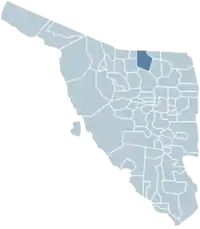 Municipality of Cananea in Sonora | |
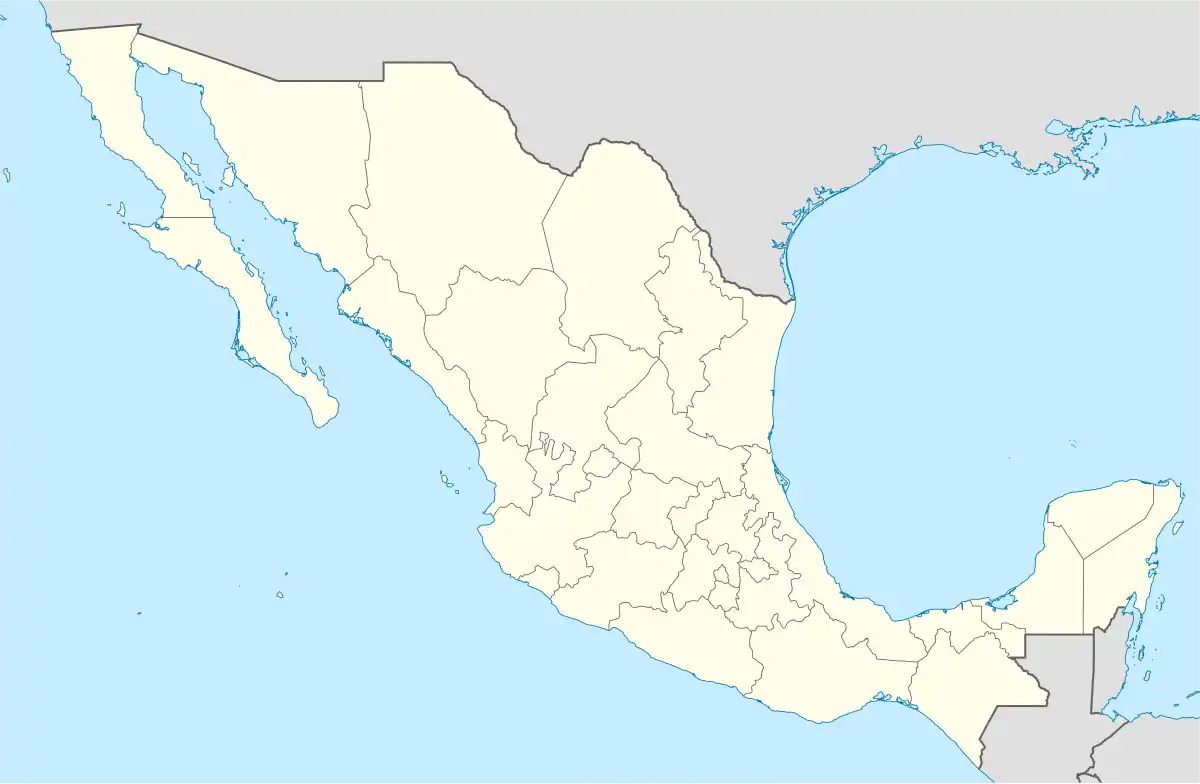 Cananea City of Cananea | |
| Coordinates: 30°58′55″N 110°18′02″W | |
| Country | Mexico |
| State | Sonora |
| Municipality | Cananea |
| Government | |
| • Type | Council-Manager Government |
| • Mayor of Cananea | Eduardo Quiroga Jiménez Independent-Nonpartisan |
| Elevation | 1,620 m (5,310 ft) |
| Population (2010) | |
| • Total | 31,560 |
| Time zone | UTC-7 (MST) |
| • Summer (DST) | UTC-7 (No DST observed) |
| Postal code | 84620 - 84635 |
| Area code(s) | 645 |
| Demonym | Cananense |
| Website | www.cananea.gob.mx |
The population of the city was 31,560 as recorded by the 2010 census. The population of the municipality, which includes rural areas, was 32,936. The total area of the municipality is approximately 4,100 square kilometres (1,600 sq mi).
History
The first non-indigenous inhabitants of the present day Cananea, arrived in 1760 from other parts of the Spanish Viceroyalty of New Spain (colonial México).
In the 19th century General Ignacio Pesqueira, from nearby Arizpe, retired to Cananea. He fought against the Apache who raided the area. One time, while following them into the mountains, he discovered the abandoned Spanish mines and by 1868 he had renewed the extraction of minerals in the Cananea mines. General Pesqueira's wife, Elena Pesqueira Pesqueira, "discovered" a nearby mountain range (sierra) and the General named the highest peak La Elenita ("The Little Helen", 9,327 feet or 2,843 meters above sea level) in her honor. The other peak is named La Mariquita ("The Little Mary", 8,123 feet or 2,476 meters above sea level).
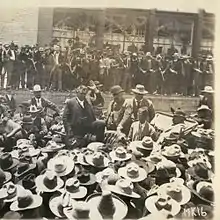
In 1889 William Cornell Greene purchased the mine from General Pesqueira and founded the Nogales, Sonora-based company, The Cananea Consolidated Copper Company, S. A. (CCCC or 4C). In June 1906, a labor dispute erupted into the violent cross-border Cananea strike, that resulted in the death of 23 people and dozens injured, in a fight between the strikers and a posse led by Arizona Rangers from the United States. A corrido titled La cárcel de Cananea ("Cananea jail") written in 1917 and commemorating the incident has since become famous. At the time of the strike the population of 23,000 included 7,000 Americans and 5,000 Chinese.[1]
On October 31, 1901, the area became a municipality with Cananea town as its seat. On July 11, 1957, Cananea town became a city.
Cananea Jail
The Cananea jail was built in 1903 and is located in downtown Cananea. It was the first public jail of the city and is currently a museum "Museo de la Lucha Obrera" with exhibitions of photographs and instruments used in mining.
La carcel de Cananea or The Cananea Jail song is a corrido that has become part of the culture of Cananea and the state of Sonora. It describes the experiences of a man accused of murdering Chinese immigrants while at this jail. According to historian Rodolfo Rascón, a man called Francisco, nicknamed El Cucharón de Batuc ("The Big Spoon of Batuc"), wrote the song in 1917.
Climate
The municipality of Cananea has a sub-humid Mediterranean climate (Köppen climate classification Csa), with an average monthly maximum temperature of 74.3 °F (23.5 °C) in the months of June to September and an average monthly minimum of 45.3 °F (7.4 °C) in December and January; the average annual temperature is 59.5 °F (15.3 °C).
Atypically for the Mediterranean climate type, the dry season occurs in spring and early summer, whereas the rainy season is in mid/late summer and autumn. Through winter the rains are less intense, but of longer duration. Called “equipatas”, they can fall in the form of snow. In the months of February, March, and April there are frequent frosts, hailstorms, and occasional snowstorms. Precipitation averages at 511 millimetres (20 in) annually.
| Climate data for Cananea, Sonora (1971-2000, extremes (1951-present) | |||||||||||||
|---|---|---|---|---|---|---|---|---|---|---|---|---|---|
| Month | Jan | Feb | Mar | Apr | May | Jun | Jul | Aug | Sep | Oct | Nov | Dec | Year |
| Record high °C (°F) | 34.0 (93.2) |
28.0 (82.4) |
29.0 (84.2) |
39.0 (102.2) |
39.0 (102.2) |
45.0 (113.0) |
42.0 (107.6) |
39.0 (102.2) |
40.0 (104.0) |
33.0 (91.4) |
29.4 (84.9) |
27.0 (80.6) |
45.0 (113.0) |
| Average high °C (°F) | 14.5 (58.1) |
16.7 (62.1) |
17.9 (64.2) |
22.4 (72.3) |
26.0 (78.8) |
32.1 (89.8) |
30.8 (87.4) |
30.1 (86.2) |
28.2 (82.8) |
23.9 (75.0) |
17.8 (64.0) |
14.3 (57.7) |
22.9 (73.2) |
| Daily mean °C (°F) | 8.5 (47.3) |
10.3 (50.5) |
11.5 (52.7) |
15.5 (59.9) |
18.7 (65.7) |
24.1 (75.4) |
23.7 (74.7) |
23.6 (74.5) |
21.4 (70.5) |
17.2 (63.0) |
11.8 (53.2) |
8.4 (47.1) |
16.2 (61.2) |
| Average low °C (°F) | 2.5 (36.5) |
4.0 (39.2) |
5.1 (41.2) |
8.6 (47.5) |
11.3 (52.3) |
16.1 (61.0) |
16.6 (61.9) |
17.0 (62.6) |
14.5 (58.1) |
10.4 (50.7) |
5.8 (42.4) |
2.5 (36.5) |
9.5 (49.1) |
| Record low °C (°F) | −14.0 (6.8) |
−8.4 (16.9) |
−7.0 (19.4) |
−4.4 (24.1) |
1.0 (33.8) |
6.0 (42.8) |
8.0 (46.4) |
7.0 (44.6) |
5.0 (41.0) |
−2.5 (27.5) |
−5.0 (23.0) |
−10.0 (14.0) |
−14.0 (6.8) |
| Average precipitation mm (inches) | 45.5 (1.79) |
28.7 (1.13) |
24.1 (0.95) |
6.2 (0.24) |
7.6 (0.30) |
17.5 (0.69) |
123.9 (4.88) |
89.6 (3.53) |
56.2 (2.21) |
46.1 (1.81) |
22.5 (0.89) |
42.8 (1.69) |
510.7 (20.11) |
| Average precipitation days | 3.3 | 2.4 | 2.1 | 0.8 | 0.8 | 2.3 | 12.5 | 8.7 | 4.9 | 3.6 | 1.8 | 3.1 | 46.3 |
| Source: Servicio Meteorológico Nacional[2][3] | |||||||||||||
City Government
Mayors
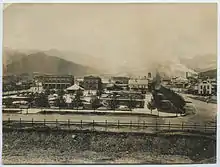
| 1901-1903 | Manuel Larrañaga | - |
| 1903-1905 | Ignacio Macmanus | - |
| 1905-1907 | Filiberto Barroso | - |
| 1907-1910 | Eduardo R. Arnold | - |
| 1910-1911 | José Clemente Arnold | - |
| 1911-1912 | Ignacio L. Pesqueira | - |
| 1912-1918 | Manuel M. Diéguez | - |
| 1918-1920 | Florentino Rocha | - |
| 1920-1921 | Julian S. González | - |
| 1922-1923 | Salvador Taylor | - |
| 1923-1924 | José Figueroa | - |
| 1923-1924 | José Figueroa | - |
| 1924-1925 | Ramón R. González | - |
| 1925-1927 | Dolores Romero | - |
| 1927-1928 | Ramón R. González | - |
| 1928-1929 | Maximiliano Zuñiga | - |
| 1929-1931 | Dolores Romero | |
| 1931-1933 | Juan Caro | |
| 1933-1935 | Ignacio F. Loaiza | |
| 1935-1937 | Ramón C. Meneses | |
| 1937-1939 | Jesús M. Molinares | |
| 1939-1941 | Alberto Matti | |
| 1941-1943 | José F. Payán | |
| 1943-1946 | Jesús González y González | |
| 1946-1949 | Jesús R. Juvera | |
| 1949-1952 | Ramón Guerrero | |
| 1952-1954 | Antonio Fernando Ruíz | |
| 1954-1955 | Rogelio Castro Cuen | |
| 1955-1958 | Fidel Sánchez Márquez | |
| 1958-1961 | Ramón Millanez | |
| 1961-1964 | Jesús Burrola Tolano | |
| 1964-1967 | Victor Manuel Tapia Berkowitz | |
| 1967-1970 | Edmundo Navarro Parra | |
| 1970-1973 | Roberto Elzy Torres | |
| 1973-1976 | Jesús Ahumada Barreda | |
| 1976-1979 | Héctor Lavander León | |
| 1979-1982 | Roberto Torres Carbajal | |
| 1982-1985 | Gildardo Monge Reyes | |
| 1985-1988 | Rafael Carrillo Monzón | |
| 1988-1991 | Francisco Javier Taddei Taddei | |
| 1991-1994 | Gildardo Monge Escárcega | |
| 1994-1997 | Héctor René Tagles Zavala | |
| 1997-2000 | Francisco García Gamez | |
| 2000-2003 | Mario César Cuen Aranda | |
| 2003-2006 | Francisco García Gamez | |
| 2006-2009 | Luis Carlos Cha Flores | |
| 2009-2012 | Jesús Reginaldo Moreno García | |
| 2012-2015 | Francisco Javier Tarazón Curlango | |
| 2015-2018 | Fernando Herrera Moreno | |
| 2018-2021 | Eduardo Quiroga Jiménez | |
Economy
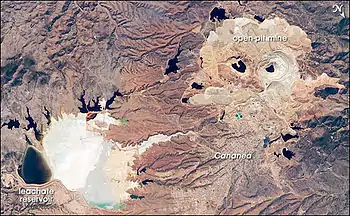
Mining
Mining is the main source of revenue for Cananea and will be for the foreseeable future. Eighty percent of the population is directly or indirectly supported by mining companies in Cananea. The first and most important mining company is Buenavista del Cobre, S.A. de C.V. (formerly Mexicana de Cananea, S.A. de C.V.) owned by the Southern Copper Corporation,[4] and still shares ownership with Grupo Mexico, S.A.B. de C.V.[5] Grupo Mexico plans to invest $3.7 Billion US Dollars at the Cananea Mine. This program is expected to increase Buenavista's production capacity from 180,000 tons of copper per year to over 450,000 tons. During 2Q11, Buenavista reached its full capacity and produced 45,588 tons of copper: 15,170 tons of copper cathode at its SX/EW Plant and 30,417 tons of copper concentrate at the Concentrator Plant. Cananea is among the world's largest copper mines in terms of reserves.
A miners strike at the Buenavista del Cobre mine lasted almost three years, until broken on the night of June 6, 2010, when Mexican police dispersed striking workers.[6] On June 6, 2011, the Confederation of Mexican Workers (“CTM”) was granted the collective bargaining agreement for the Buenavista union, replacing the miner's National Union of Mining and Metallurgical Workers Sindicate, Section No.65 (Labor Union), headed by Napoleón Gómez Urrutia, People celebrate these days of mining copper in a festival in Cananea in the town square called "La Feria De Cobre" (translates to "The Copper Festival"
The second and smaller active copper mine is "Minera Maria", owned by Minera Frisco, S.A.B. de C.V. a Mexican company controlled by Carlos Slim Helú and family, including Inmobiliaria Carso, S.A. de C.V. and located west of Cananea. The plant has an installed monthly production capacity of 2,500 tons of copper cathode.
Industry
Light industry is the second most important activity in the local economy, generating approximately 3,100 jobs. A modest industrial park north of the town comprises an area of 53 acres (210,000 m2). There are several companies operating as maquiladoras. The most important were co-founded by Mr. Benjamin Schirrmeister which they are "Fullfillmen Systems de México", "Stewart Connectors Systems de Mexico" , "Datacenter del Norte", "Customer Specific Cables". In other section they have "Fundidora de Cananea, S.A.", a manufacturer of ball mill liners, and "Road Machinery Company de México, S.A." -- which all aforementioned companies together provide approximately 600 jobs and are involved in diverse activities, from cable assembly to steel fabrication.
The intent to open a concrete products industrial park north of Cananea was announced in January 2018 by Ing. Glenn Edward Roy E. of "Ferrocret", a conglomerate that shall produce all manner of precast concrete products such as: hydro conduit; walls, floors, and ceilings of affordable housing; drycast concrete pavers; cinder block; concrete railway sleepers. The factories will utilise proprietary fast-cure concrete formulations in combination with the abundant nearly free-of-cost copper slag "escoria" -- an aggregate alternative to expensive riverbed-mined gravel. Over one hundred years of mining activities at Cananea have generated huge manmade mountains of copper slag... thereby providing an ideal, low-cost alternative for supplying graded aggregates for inclusion within those various precast concrete products. Precast concrete products manufacturing promises to become a major industry in the region, and one which shall lessen the dependence of the Cananea job force on a local economy that historically solely has been dependent upon the mines remaining open.
Agriculture
Cattle raising is important and there were approximately 16,000 head in the last census.
Farming consists mainly of corn, potatoes, beans, sorghum, alfalfa, barley, and apples. Most of these crops are used for local consumption and cattle fodder. The infrastructure consists of 30 wells, equipped with a system of electrical motors, and 10 kilometers (6 mi) of reinforced canals used for irrigation.
Twin towns
 Rio Blanco, Veracruz, Mexico (1980)
Rio Blanco, Veracruz, Mexico (1980) Sierra Vista, Arizona, United States (1989)
Sierra Vista, Arizona, United States (1989) Radebeul, Germany (2004)
Radebeul, Germany (2004) Tijuana, Baja California, Mexico (2007)
Tijuana, Baja California, Mexico (2007) Bisbee, Arizona, United States (2014)
Bisbee, Arizona, United States (2014)
Notable residents
- Raul Hector Castro - 14th Governor of U.S. State of Arizona
- William Cornell Greene - Founder of modern Cananea, The Greene Consolidated Copper Company and The Cananea Consolidated Copper Company.
- Aurelio Rodríguez - Mexican Baseball Hall of Fame inductee
- Claudio Xavier Gonzalez Laporte Chairman of Kimberly-Clark de México and President of the Mexican Business Council.
- Benjamín Eduardo Schirrmeister Jaime co-founder of "Fullfillmen Systems de México", "Stewart Connectors Systems de Mexico" , "Datacenter del Norte", and "Customer Specific Cables"
References
- "WENT AGAINST ORDERS; Governor of Arizona Warned Capt. Rynning and Other Americans", New York Times, June 3, 1906.
- "NORMALES CLIMATOLÓGICAS 1971-2000" (in Spanish). Servicio Meteorológico Nacional. Retrieved June 1, 2017.
- "Extreme Temperatures and Precipitation for Cananea 1951-2010" (in Spanish). Servicio Meteorológico Nacional. Retrieved June 1, 2017.
- Southern Copper Corporation. (NYSE:SCCO Archived October 12, 2012, at the Wayback Machine
- Grupo Mexico, S.A.B. de C.V. (BMV:GMEXICO Archived March 5, 2012, at the Wayback Machine
- Elisabeth Malkin (June 7, 2010). "Police Officers End a Mine Strike in Mexico". New York Times.
- (in Spanish) Site of the presidency of the municipality of Cananea
- (in Spanish) Cananea at the site of the Government of Sonora
- (in Spanish) The Cananea Strike at the Universidad Obrera de México
- (in Spanish) Cananea at La Jornada
- (in Spanish) http://www.elimparcial.com/EdicionEnLinea/Notas/Noticias/28052007/242450.aspx%5B%5D
- (in Spanish) Sindicato Minero Seccion 65 of Cananea
External links
- (in Spanish)—Official Cananea Municipal Government website